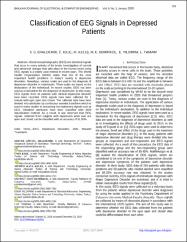Classification of EEG Signals in DepressedPatients

Göster/
Tarih
2020Yazar
Eraldemir, Server GökselKılıç, Ümit
Keleş, Mümine Kaya
Demirkol, Mehmet Emin
Yıldırım, Esen
Tamam, Lut
Üst veri
Tüm öğe kaydını gösterKünye
Eraldemir, S. G., Kılıç, Ü., Kaya Keleş, M., Demirkol, M. E., Yıldırım, E. & Tamam, L. (2020). Classification of EEG Signals in Depressed Patients. Balkan Journal of Electrical and Computer Engineering, 8 (1), 103-107. https://doi.org/10.17694/bajece.631951Özet
Electroencephalography (EEG) are electrical signals that occur in every activity of the brain. Investigation of normal and abnormal changes that take place in the human brain using EEG signals is a widely used method in recent years. The World Health Organization (WHO) states that one of the most important health problems in today's society is depressive disorders. Nowadays, various scales are used in the diagnosis of depressive disorder in individuals. These scales are based on the declaration of the individual. In recent studies, EEG has been used as a biomarker for the diagnosis of depression. In this study, EEG signals from 30 patients with clinical depressive disorder have been recorded. EEG signals have been collected for 1 minute with eyes open and closed. The collected data have been divided into attributes by continuous wavelet transform which is used in many studies in processing non-stationary signals such as EEG. Obtained attributes have been classified with kNN classification method. As a result, it was observed that EEG signals, collected from subjects with depression while eyes are open and closed, can be classified with an accuracy of 91.30%.
Kaynak
Balkan Journal of Electrical and Computer EngineeringCilt
8Sayı
1Bağlantı
https://doi.org/10.17694/bajece.631951https://dergipark.org.tr/tr/pub/bajece/issue/52149/631951
https://hdl.handle.net/20.500.12508/2541















